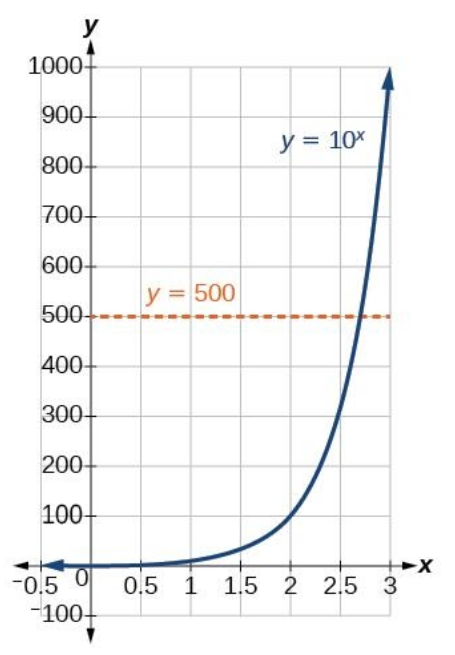6.2: Logarithmic Scales in Natural Sciences
- Page ID
- 50951

In 2010, a major earthquake struck Haiti, destroying or damaging over 285,000 homes[1]. One year later, another, stronger earthquake devastated Honshu, Japan, destroying or damaging over 332,000 buildings,[2] like those shown in the image above. Even though both caused substantial damage, the earthquake in Japan was 100 times as strong as the earthquake in Haiti. How do we know? The magnitudes of earthquakes are measured on a scale known as the Richter Scale. The Haitian earthquake registered a 7.0 on the Richter Scale[3] whereas the Japanese earthquake registered a 9.0.[4]
The Richter Scale is a base-ten logarithmic scale. In other words, an earthquake of magnitude 8 is not twice as great as an earthquake of magnitude 4. It is 108-4=104=10,000 times as great! In this section, we will investigate the nature of the Richter Scale and the base-ten function upon which it depends.
Converting from Logarithmic to Exponential Form
In order to analyze the magnitude of earthquakes or compare the magnitudes of two different earthquakes, we need to be able to convert between logarithmic and exponential form. For example, suppose the amount of energy released from one earthquake were 500 times greater than the amount of energy released from another. We want to calculate the difference in magnitude. The equation that represents this problem is \(10^{x}=500\), where \(x\) the difference in magnitudes on the Richter Scale. How would we solve for \(x\)?
We have not yet learned a method for solving exponential equations. None of the algebraic tools discussed so far is sufficient to solve \(10^{x}=500\). We know that \(10^{2}=100\) and \(10^{3}=1000\), so it is clear that \(x\) must be some value between 2 and 3, since \(y=10^{x}\) increasing. We can examine a graph, below, to better estimate the solution.

Using Common Logarithms
Sometimes we may see a logarithm written without a base. In this case, we assume that the base is 10. In other words, the expression \(\log (x)\) means \(\log _{10}(x)\). We call a base-10 logarithm a common logarithm. Common logarithms are used to measure the Richter Scale mentioned at the beginning of the section. Scales for measuring the brightness of stars and the pH of acids and bases also use common logarithms.
Definition: Common Logarithm
A common logarithm is a logarithm with base 10. We write \(\log _{10}(x)\) simply as \(\log (x)\). The common logarithm of a positive number \(x\) satisfies the following definition.
For \(x>0\)
\(y=\log (x)\) is equivalent to \(10^{y}=x\)
We read \(\log (x)\) as, “the logarithm with base 10 of \(x\)” or “log base 10 of \(x\).”
The logarithm \(y\) is the exponent to which 10 must be raised to get \(x\).
How to
Given a common logarithm of the form \(y=\log (x)\), evaluate it mentally.
- Rewrite the argument x as a power of \(10: 10^{y}=x\).
- Use previous knowledge of powers of 10 to identify \(y\) by asking, “To what exponent must 10 be raised in order to get \(y\)?
Example \(\PageIndex{1}\): Finding value of a common Logarithm Mentally
Evaluate \(y=\log (1000)\) without using a calculator.
Solution
First we rewrite the logarithm in exponential form: \(10^{y}=1000\). Next, we ask, “To what exponent must 10 be raised in order to get 1000?” We know
\[\begin{aligned}
10^{3}&=1000\\
\therefore \log (1000)&=3
\end{aligned} \nonumber \]
Try it Now 4
Evaluate \(y=\log (1,000,000)\).
How to
Given a common logarithm with the form \(y=\log (x)\), evaluate it using a calculator.
- Press [LOG].
- Enter the value given for x followed by [ ) ].
- Press [ENTER].
Example \(\PageIndex{2}\): Finding value of a common Logarithm using a Calculator
Evaluate \(y=\log (321)\) to four decimal places using a calculator.
Solution
- Press [LOG].
- Enter 321, followed by [ ) ].
- Press [ENTER].
Rounding to four decimal places, \(\log (321) \approx 2.5065\).
Analysis
Note that \(10^{2}=100\) and that \(10^{3}=1000\). Since 321 is between 100 and 1000, we know that \(\log (321)\) must be between \(\log (100)\) and \(\log (1000)\). This gives us the following:
\[\begin{array}{l}
100<321<1000 \\
2<205065<3
\end{array} \nonumber \]
Try it Now 5
Evaluate \(y = \log(123)\) to four decimal places using a calculator.
Example \(\PageIndex{3}\)
The 1994 Northridge Earthquake in Southern California registered a 6.7 on the Richter scale. Exactly a year later, the 1995 Kobe Earthquake in Japan registered a 6.9. Compare the amount of energy released from these two quakes.
Solution
\[10^{6.9-6.7}=10^{0.2}=1.585 \nonumber \]
The Kobe Earthquake released about 1.56 times the energy (about 56% more) released by the Northridge quake.
Example \(\PageIndex{4}\): Rewriting and solving a real-world exponential model
The amount of energy released from one earthquake was 500 times greater than the amount of energy released from another. The equation \(10^x=500\) represents this situation, where \(x\) is the difference in magnitudes on the Richter Scale. To the nearest thousandth, what was the difference in magnitudes?
Solution
We begin by rewriting the exponential equation in logarithmic form.
\[\begin{aligned}
10^{x} &= 500\\
\log (500) &= x \quad \text {Use the definition of the common log.}
\end{aligned} \nonumber \]
Next we evaluate the logarithm using a calculator:
- Press [LOG].
- Enter 500, followed by [ ) ].
- Press [ENTER].
- To the nearest thousandth, \(\log (500) \approx 2.699\).
The difference in magnitudes was about 2.699. This means that the bigger earthquake has the magnitude about 2.7 more than the magnitude of the smaller earthquake.
Try it Now 6
The amount of energy released from one earthquake was 8,500 times as great as the amount of energy released from another. The equation \(10^x=8500\) represents this situation, where \(x\) is the difference in magnitudes on the Richter Scale. To the nearest thousandth, what was the difference in magnitudes?
Reference
- References (14)
Contributors and Attributions
Saburo Matsumoto
CC-BY-4.0

